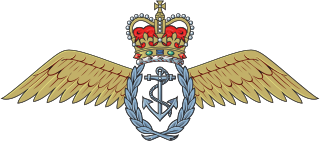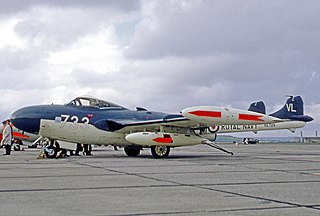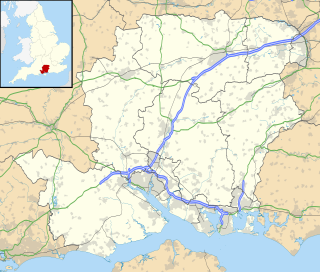Related Research Articles

The Fleet Air Arm (FAA) is one of the five fighting arms of the Royal Navy and is responsible for the delivery of naval air power both from land and at sea. The Fleet Air Arm operates the F-35 Lightning II in a Maritime Strike Role, the AW159 Wildcat and AW101 Merlin in both Commando and Anti-Submarine roles, and the BAE Hawk in an aggressor role.

The Fairey Barracuda was a British carrier-borne torpedo and dive bomber designed by Fairey Aviation. It was the first aircraft of this type operated by the Royal Navy's Fleet Air Arm (FAA) to be fabricated entirely from metal.

The British Pacific Fleet (BPF) was a Royal Navy formation that saw action against Japan during the Second World War. The fleet was composed of Commonwealth naval vessels. The BPF formally came into being on 22 November 1944 from the remaining ships of the former Eastern Fleet then being re-named the East Indies Fleet and continuing to be based in Trincomalee. The British Pacific Fleet's main base was at Sydney, Australia, with a forward base at Manus Island. One of the largest fleets ever assembled by the Royal Navy, by Victory over Japan Day it consisted of over two hundred ships and submarines and more than 750 aircraft; including four battleships and six fleet aircraft carriers, fifteen smaller aircraft carriers, eleven cruisers and numerous smaller warships, submarines, and support vessels. The fleet took part in the Battle of Okinawa and the final naval strikes on Japan.

The de Havilland Sea Venom is a British postwar carrier-capable jet aircraft developed from the de Havilland Venom. It served with the Royal Navy Fleet Air Arm and with the Royal Australian Navy. The French Navy operated the Aquilon, a version of the Sea Venom FAW.20 licence-built by SNCASE (Sud-Est).

Royal Naval Air Station Lee-on-Solent was one of the primary shore airfields of the Fleet Air Arm. First established as a seaplane base in 1917 during the First World War, it later became the main training establishment and administrative centre of the Fleet Air Arm. Situated near Lee-on-the-Solent in Hampshire, approximately four miles west of Portsmouth on the coast of the Solent at grid reference SU560019, the establishment has now been closed down. The airfield hosts the Solent Enterprise Zone.

The Percival Prince is a British light transport of the early postwar period. It was a twin-engine, high-wing, cantilever monoplane of all-metal stressed-skin construction; the undercarriage was of retractable, tricycle type.

Naval Air Station Squantum was an active naval aviation facility during 1917 and from 1923 until 1953. The original civilian airfield that preceded it, the Harvard Aviation Field, dates back to 1910. The base was sited on Squantum Point in the city of Quincy, Massachusetts. It also abutted Dorchester Bay, Quincy Bay, and the Neponset River.
701 Naval Air Squadron was a Royal Navy Fleet Air Arm squadron, formed on 24 May 1939, that saw service during the Second World War.

814 Naval Air Squadron or 814 NAS, nicknamed the Flying Tigers, is a squadron of the Royal Navy Fleet Air Arm. It is currently equipped with the AgustaWestland Merlin HM2 anti-submarine warfare helicopter and is based at Royal Naval Air Station (RNAS) Culdrose in Cornwall. The squadron was formed in December 1938 and has been disbanded and reformed several times.

Royal Naval Air Station Eglinton or RNAS Eglinton was a Royal Naval Air Station located 1.3 miles (2.1 km) north east of Eglinton, County Londonderry, Northern Ireland. It opened as a Royal Air Force Station in 1941, before being transferred to the Fleet Air Arm in 1943.

880 Naval Air Squadron was a Royal Navy Fleet Air Arm carrier based squadron formed in January 1941. The squadron served throughout the Second World War being embarked in the carriers HMS Furious, Indomitable, Argus and Implacable serving off East Africa, in the Mediterranean, off Norway and in the Far East. 880 Squadron was disbanded two weeks after VJ day at the Mobile Naval Air Base HMS Nabswick at Schofields, Sydney, Australia.
831 Naval Air Squadron was a Naval Air Squadron of the Royal Navy's Fleet Air Arm. The squadron was reformed twice: firstly from 21 November 1955 - 10 December 1957 and then from 1 May 1958 - 26 August 1966. The cartoon character Flook was adopted as a squadron mascot in the era following World War 2 and painted as nose art on aircraft.
834 Naval Air Squadron was a Naval Air Squadron of the Royal Navy's Fleet Air Arm.

842 Naval Air Squadron was a Naval Air Squadron of the Royal Navy's Fleet Air Arm.
852 Naval Air Squadron was a Naval Air Squadron of the Royal Navy's Fleet Air Arm.
877 Naval Air Squadron was a Naval Air Squadron of the Royal Navy's Fleet Air Arm. The squadron formed at Tanga, East Africa in April 1943 as a Fleet Fighter unit for local defence duties, using RAF Hurricane IIBs. In July 1943 the squadron moved to Port Reitz, Mombasa with the intention to fly with long-range fuel tanks to the defence of Ceylon but this was cancelled and the squadron disbanded in December 1943.
890 Naval Air Squadron was a Naval Air Squadron of the Royal Navy's Fleet Air Arm.
861 Naval Air Squadron was a Naval Air Squadron of the Royal Navy's Fleet Air Arm.
References
- ↑ "850 Squadron". Fleet Air Arm Archive. Archived from the original on 24 September 2015. Retrieved 12 December 2014.
| This United Kingdom navy-related article is a stub. You can help Wikipedia by expanding it. |